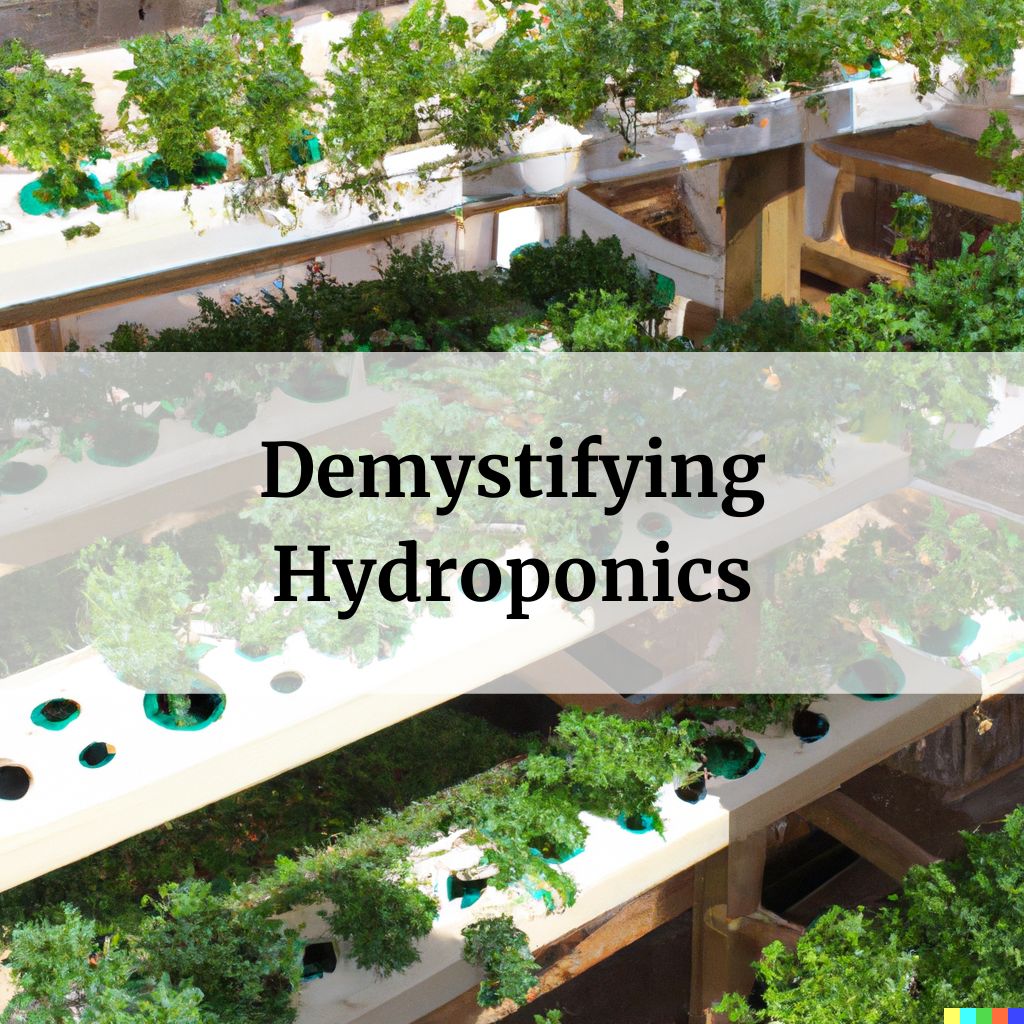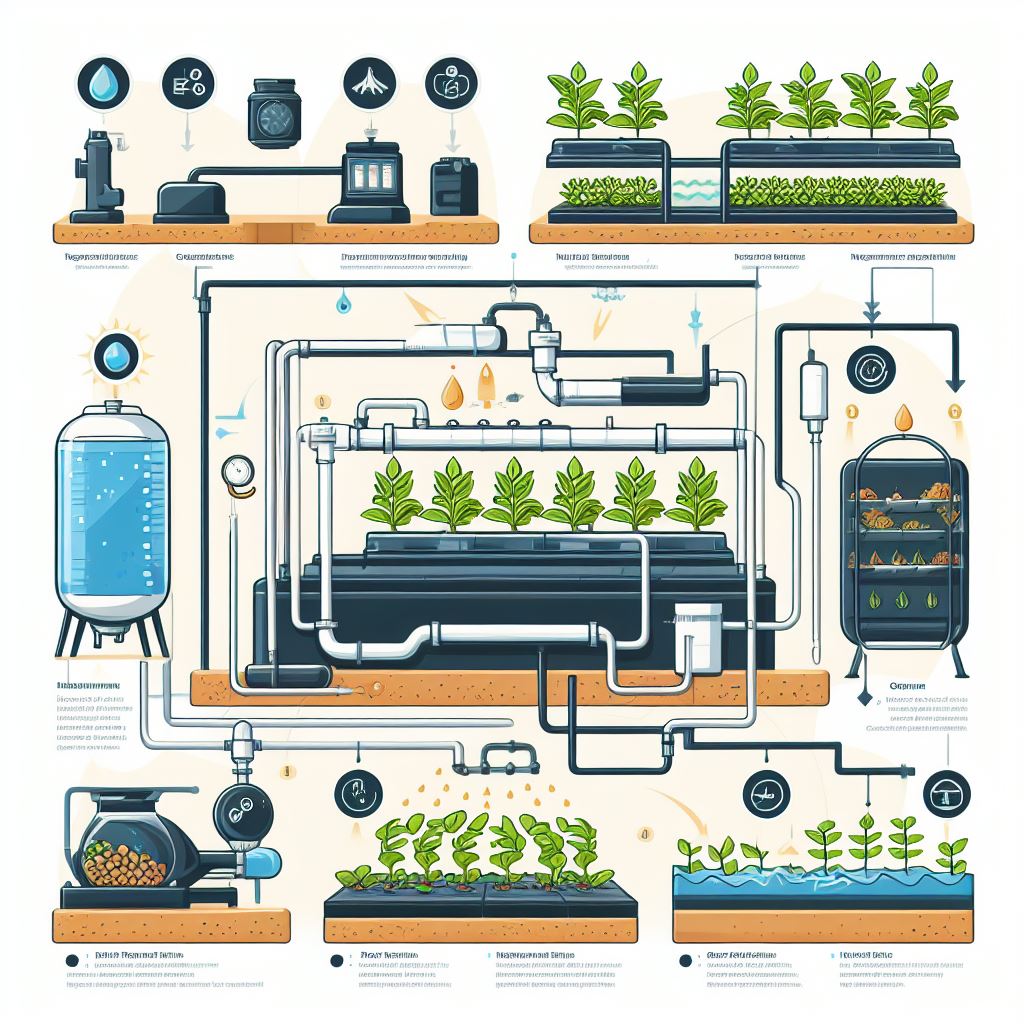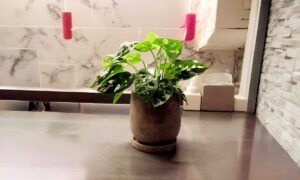
Hydroponic gardening is a revolutionary method of growing plants in optimized water and nutrient solutions rather than soil. It offers the potential to overcome traditional gardening limitations and create thriving gardens. We look at the components and mechanics of hydroponics, providing insights into how it works and its benefits.
In this article
- 1 How Hydroponics Works
- 2 The Components of a Hydroponic System
- 3 Types of Hydroponic Systems
- 4 Nutrient Requirements in Hydroponics
- 5 Selecting Growing Media
- 6 Aerating Your Nutrient Reservoir
- 7 Monitoring Your Hydroponic Nutrient Solution
- 8 Advanced Hydroponic Techniques
- 9 Troubleshooting Common Hydroponic Issues
- 10 Conclusion
How Hydroponics Works
Hydroponics is based on a simple premise – plants don’t inherently need soil, they just need water, nutrients, oxygen, and light. With hydroponic systems, inert growing media is used instead of soil to anchor plants, while water delivers essential nutrients directly to the roots.
The Role of Water
In hydroponics, water performs the vital functions normally provided by soil. The nutrient-rich water solution gives plants the minerals, nitrogen, and other elements they need to grow. Water also provides hydration and transports nutrients through the whole plant via transpiration and osmosis.
Additionally, water helps transport oxygen to the plants’ root systems. Proper oxygenation is crucial for healthy root development and nutrient absorption. Hydroponic systems use air pumps, water circulation, or splashing actions to oxygenate the nutrient solution.
Essential Requirements for Growth
Besides water and nutrients, plants need adequate sunlight, carbon dioxide, and oxygen to undergo photosynthesis and respiration for growth.
Sunlight provides the energy source for plants to convert carbon dioxide and water into glucose and oxygen. Grow lights are used for indoor hydroponic gardening to mimic natural sunlight in the appropriate light spectrum.
With good exposure to these essential inputs – water, nutrients, light, carbon dioxide, and oxygen – plants can thrive in hydroponic systems without needing soil.
Comparing Soil and Hydroponics
In traditional gardening, the soil acts as a mineral nutrient bank and a substrate that anchors plants.
However, soil also comes with disadvantages:
- It harbors diseases, pests, and weeds
- Water and nutrients can be wasted through drainage or evaporation from the soil
- Soil requires amendments to achieve ideal pH and nutrient balances
Meanwhile, hydroponic systems provide a sterile, controlled environment. Nutrient levels are optimized in the water solution, without soil pathogens and pests. The inert growing media in hydroponics simply supports plants mechanically, while all mineral nutrition is delivered directly to the roots.
This precise control over the plant’s environment is what makes hydroponics so effective. By giving plants exactly what they need, impressive growth rates and yields are possible.
The Components of a Hydroponic System

While there are many types of hydroponic systems, they contain similar components that perform key functions:
Growing Media
Since no soil is used in hydroponics, an inert growing media is used instead to anchor plant roots and stabilize them. Common options include:
- Perlite
- Vermiculite
- Coco coir
- Rockwool
- Gravel
- Sand
These media provide no nutrients but have excellent aeration and water retention properties to support healthy root growth.
Air Stones and Air Pumps
Another critical component is air stones or air diffusers. Connected to air pumps, these bubbly stones oxygenate the nutrient solution, similar to aquatic plants.
The extra oxygen encourages faster nutrient absorption and bigger, more vigorous root systems. Proper aeration and circulation prevents problems like algae growth.
Net Pots
Net pots made from mesh or fabric contain the growing media and plant roots while allowing contact with water and nutrients. Plants are inserted into these pots as plant starters or clones.
The openings in the net pot give emerging roots access to oxygen and nutrient solution for optimal growth, while keeping the plant upright.
Types of Hydroponic Systems
There are several common types of hydroponic systems used by home and commercial growers. They can be classified based on how the nutrient solution is delivered to the plants:
Deep Water Culture (DWC) Systems
Also called float, raft, or NFT (nutrient film technique) systems, deep water culture uses aerated nutrient solution in reservoir tubs or channels. Plants in net pots sit suspended in the water, with roots submerged.
Air stones constantly deliver oxygen, while the water brings nutrients to the roots. The aerated, circulating solution creates an optimal environment for plants to thrive.
Advantages of DWC systems:
- Excellent oxygenation for robust root growth
- Easy monitoring of pH and nutrient levels
- Simple design and low maintenance
Potential disadvantages:
- Increased chances of root diseases
- Requires frequent refilling of reservoir
DWC systems work especially well for fast-growing greens and lettuces that need maximal nutrient absorption.
Wick Systems
In wick or passive hydroponic systems, the nutrient solution is delivered passively using capillary action through a “wicking” medium.
One end of growing media like yarn or felt touches the reservoir, while the other end passes into the plant’s net pot. The wicking action slowly transports nutrients upward to the plant roots.
Wick systems are inexpensive and simple to set up, not requiring any power. Their slower nutrient delivery rate also reduces root burn risks. However, the reservoir needs frequent monitoring, and clogging can impede the wicking.
Low-maintenance plants like herbs and leafy greens are well-suited to wick systems. The key is choosing a wicking medium that holds enough solution while resisting decomposition.
Nutrient Requirements in Hydroponics
Unlike soil’s natural nutrition, the right concentrated nutrient solutions must be manually added to hydroponic systems. This complete control allows optimizing plant growth by giving them exactly what they need.
17 Essential Nutrients
Plants require 17 essential mineral elements to complete their life cycles. These nutrients are divided into macronutrients and micronutrients based on the amounts needed.
Macronutrients – Required in larger amounts:
- Nitrogen
- Phosphorus
- Potassium
- Calcium
- Sulphur
- Magnesium
Micronutrients – Needed in smaller quantities:
- Iron
- Manganese
- Zinc
- Copper
- Boron
- Molybdenum
- Chlorine
- Nickel
The Importance of Macronutrients
Nitrogen, phosphorus, and potassium are crucial macronutrients plants need substantial amounts of.
Nitrogen is key for leafy growth and plant proteins. Phosphorus aids in root, flower, and fruit development. Potassium is vital for water regulation, nutrient movement, and general plant vigor.
Other macronutrients like calcium, magnesium, and sulfur also play important roles in plant structure, photosynthesis, and enzymatic processes.
Getting the right balance of these essential nutrients is critical for healthy hydroponic plant growth. This is achieved through complete, specialized hydroponic nutrient solutions.
By understanding what plants need and how hydroponics delivers it, the mechanics behind this soil-less gardening method start to make sense. With proper inputs and system maintenance, hydroponics allows plants to thrive and produce abundant yields. The techniques can scale from small home operations to fully automated commercial farms.
Selecting Growing Media

Choosing appropriate growing media is important for hydroponic gardening success. The media anchors plant roots and maintains moisture levels. Ideal media is inert, stable, lightweight, porous, and affordable.
Popular options include:
Rockwool
Made from spun volcanic basalt rock, rockwool has high water retention and drainage. It provides excellent aeration for rapid growth. However, it requires pre-soaking to stabilize pH before use.
Coconut Coir
Coconut coir is a renewable byproduct of coconut husks, avoiding depletion of peat bogs. Its mix of fine and coarse fibers suits many plants. It may need added calcium and wetting agents though.
Perlite
This porous, lightweight volcanic glass maintains moisture while allowing ample air. Perlite is inexpensive but can be messy. Combining it with coir or peat creates an ideal grow medium.
Vermiculite
Vermiculite is an expanded mica mineral with great water holding capacity. It compacts over time but provides good aeration for seedlings when blended with other media.
Gravel/Sand
Though not as efficient for moisture retention, gravel and sand are cheap, reusable, and allow excellent drainage. Their weight makes them less ideal for vertical or hanging systems.
Expanded Clay Pellets
These pea-sized ceramic pellets offer a tough, porous structure. They are sterile and reusable but relatively expensive. Pellets require close monitoring of moisture levels.
The ideal media for your needs depends on plant types, system design, and environmental conditions. Ease of use, cost, and sustainability should also be considered. Testing different options is often the best way to determine what works for your specific hydroponic operation.
Aerating Your Nutrient Reservoir
Proper aeration and circulation in the reservoir ensures your plant roots get sufficient oxygen. Stagnant, unaerated systems can quickly become oxygen deficient. There are several equipment options to optimize oxygen levels:
Air Stones
Air stones connected to pumps are the simplest way to increase oxygen. The fine bubbles they create give excellent surface contact and diffusion. Use enough air stones for the reservoir size, placing them near the root systems.
Water Pumps
Submersible water pumps agitate the solution, splashing and circulating the water to drive out dissolved gases and absorb oxygen. Position the pumps away from roots to prevent damage.
Venturi Systems
Venturi devices use pressure differentials in pipe structures to draw in and dissolve air. Venturis provide circulation while infusing large amounts of oxygen.
Lab Ventilation
Running ducting, fans, and exhausts in your hydroponic lab area improves overall air exchange and maintains oxygen availability.
Adequate aeration sustains roots and beneficial microorganisms that keep your system balanced. Monitor for signs of poor oxygen like slimy roots or slow growth. A vigorous bubbling system is essential for healthy hydroponics.
Monitoring Your Hydroponic Nutrient Solution
Careful monitoring maintains the ideal conditions in your nutrient reservoir for robust plant growth and production. Key parameters to track include:
pH Levels
The pH indicates how acidic or alkaline the water solution is on a scale of 0-14. Most plants grow best within a pH range of 5.5 to 6.5. Out of range pH will lock out nutrients. Measure frequently with a pH probe or test strips.
Nutrient Concentration
Excess salts from too high fertility burn roots while deficiency stresses plants. Use an EC/TDS meter to track targets for your crop. Refresh reservoirs every 1-2 weeks and monitor changes.
Water Temperature
Aim to keep water temp in the 66-74°F range. Higher heat promotes pathogen growth. Monitor with a thermometer and use chillers or heaters to maintain consistency.
Overall Sanitation
Prevent algal blooms and root diseases by keeping systems clean. Disinfect with hydrogen peroxide and replace equipment regularly. Keep reservoirs covered.
By routinely checking these parameters, you can correct issues like pH fluctuations before they affect plant health and yields.
Advanced Hydroponic Techniques
Experienced hydroponic growers can implement certain techniques to take their operations to the next level:
Automation
Controlling pumps, lighting, fertigation, and environmental factors with smart technology allows precise automation for optimized growth. This reduces labor and allows remote monitoring.
Hybrid Hydroponics
Combining hydroponics with other methods like aquaponics (fish farming) or aeroponics (air root spraying) integrates best practices for resource use efficiency.
Vertical Farming
Stacking layers of plants in vertical hydroponic racks greatly multiplies production area. Vertical farms allow urban FRESH food production.
High-Intensity Lighting
Specialized grow lights like high-pressure sodium or LEDs maximize light energy. They enhance photosynthesis and growth, especially in stacked layers.
Climate Control
Maintaining ideal temp, humidity, ventilation, light levels, etc maximizes yields. Greenhouse polytunnels with hydroponics leverage these optimized conditions.
Data-driven Nutrient Dosing
Sensors that track pH, EC, oxygen, etc allow real-time adjustment of nutrients and conditions for precision growing. This prevents issues and tailors inputs.
By leveraging these advanced techniques, commercial hydroponic farms achieve extremely high productivity and profitability. Hobby systems can also incorporate automation for added convenience.
Troubleshooting Common Hydroponic Issues
While hydroponics offers advantages over soil gardening, it does come with its own challenges and issues to navigate:
Poor Oxygenation
Insufficient aeration from failing air pumps or lack of water circulation slows growth. Check for slimy roots and upgrade your oxygenation system.
Nutrient Deficiencies
Wrong pH, inadequate nutrients, or unsuitable water can all cause deficiencies. Test and adjust levels, trying a different nutrient blend if needed.
Equipment Malfunction
Pump failures, leaks, clogged lines, electrical issues, and other technical problems can arise. Have backup systems and parts ready for quick repairs.
Reservoir Contamination
Dirty reservoirs, dead roots, algae growth, and bacteria can compromise systems. Disinfect and replace solution. Ensure good sanitation.
Pest Infestations
While less common than soil gardening, insects, mites, and fungi can still invade. Use screens, beneficial insects, organic sprays, and sterilization.
Excessive Heat/Cold
Temperature extremes damage sensitive roots and affect growth. Regulate ambient and water temperature for optimal ranges.
Patience and vigilance in regularly monitoring your hydroponic system will allow catching and correcting issues promptly. Learn from each challenge to improve your operation over time.
Conclusion
When broken down to its fundamentals, hydroponic gardening is a relatively simple concept: delivering water, nutrients and oxygen efficiently to allow plants to thrive without soil.
By understanding components like growing media, reservoirs, pumps and aeration, we gain insight into how hydroponics leverages precision control over the plant’s environment for excellent results.
With some basic equipment of net pots, nutrient mixes, and a reservoir, it’s easy to get started experimenting with hydroponics at home. More advanced systems incorporate automation and innovative techniques to maximize productivity.
No matter your scale, embracing the mechanics behind hydroponics is the key to success. Monitoring and adjusting pH, oxygen, nutrients, and other factors creates optimal conditions for healthy roots and vigorous growth.
If you want to unlock the potential behind soil-less gardening, hydroponics offers a proven framework rooted in meeting plants’ needs. Allow your green thumb to blossom by exploring the foundational principles and components covered here. Growing abundantly without soil is an empowering feat of human ingenuity.
Citations:







